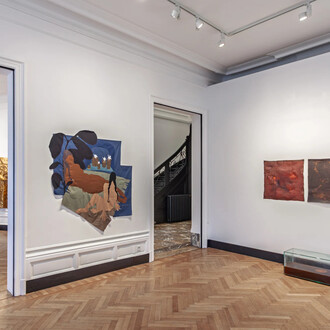Mathieu is known as an interdisciplinary artist, but is always drawn back to his paintbrushes.
This young artist creates cerebral, stylized paintings that are at once highly personal and provocative, yet at the same time slightly unnerving in their intimacy. He often invokes his native country’s political history as a springboard: Mathieu was born in the year that the Haitian uprising brought the Duvalier era to an end, and he is named after the protagonist in Jacques Roumain’s 1941 Haitian classic novel Gouverneurs de la rosée, or Master of the Dew. As such, haunting, gory forms resembling people or body parts appear in his paintings, figures that are seemingly adrift in an anonymous setting—and always appear to be alone. Yet his work is also incredibly physical. “I deal with images like structures,” Mathieu explains, initially “destroying” them, and then, through a variety of techniques—like scratching and frottage, insertion, drawing, and dripping–he attempts to make them reappear again. The point at which he deems a work “complete” can range from a day to months, in a process that the artist compares to “running in the dark: eventually you hit something, and you know.”
Mathieu's work has been shown in several museumslisting group shows including the Grand Palais, Paris; Museum of the Americas, Washington, D.C.; Musée d’art contemporain de Montréal, Quebec; and most recently, a solo outing at the Institute of Contemporary Art, London.
















